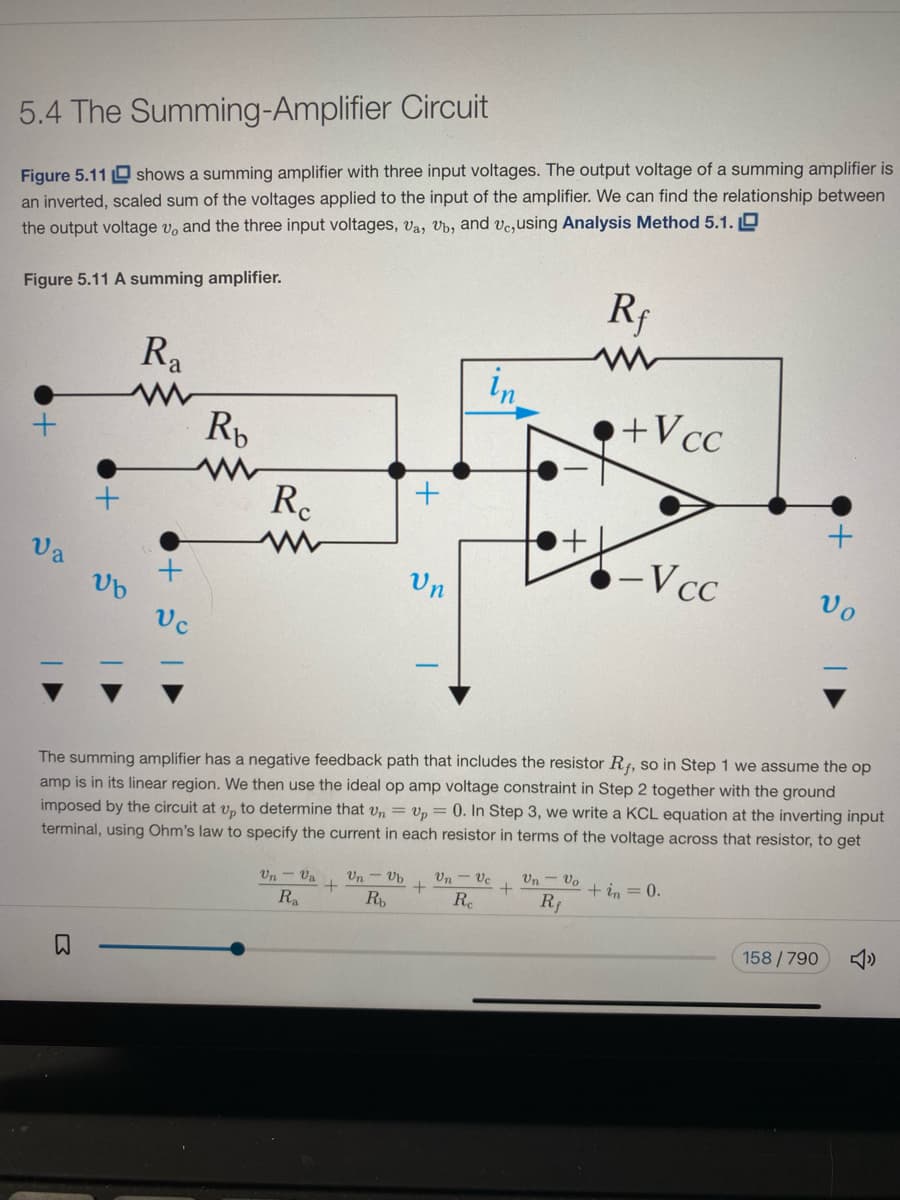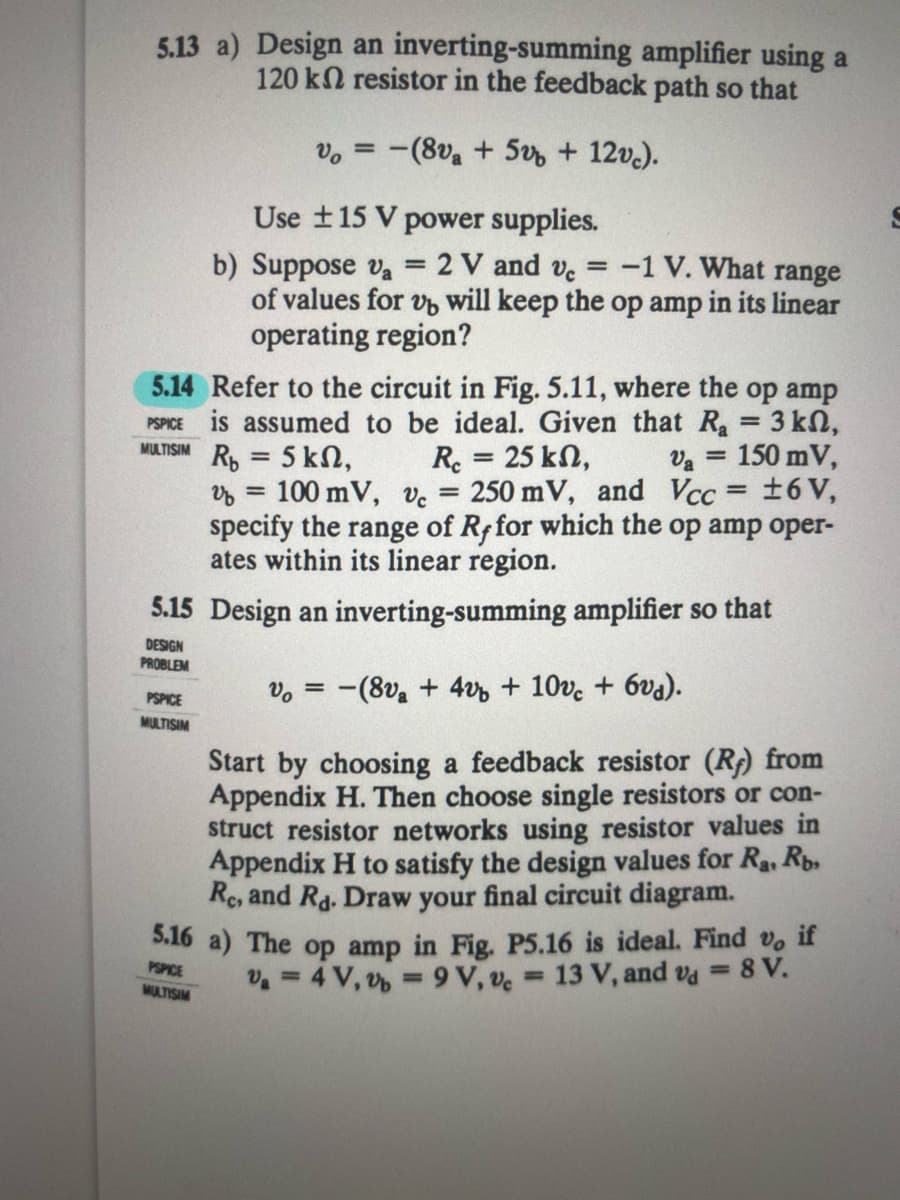5.14 Refer to the circuit in Fig. 5.11, where the op amp PSPICE is assumed to be ideal. Given that Ra = 3 kn, Va = 150 mV, ±6 V, MULTISIM 5 kΩ, = 100 mV, ve specify the range of Rffor which the op amp oper- ates within its linear region. R = 5 kN, Re = 25 kN, 250 mV, and Vcc %3D %3| ||
5.14 Refer to the circuit in Fig. 5.11, where the op amp PSPICE is assumed to be ideal. Given that Ra = 3 kn, Va = 150 mV, ±6 V, MULTISIM 5 kΩ, = 100 mV, ve specify the range of Rffor which the op amp oper- ates within its linear region. R = 5 kN, Re = 25 kN, 250 mV, and Vcc %3D %3| ||
Introductory Circuit Analysis (13th Edition)
13th Edition
ISBN:9780133923605
Author:Robert L. Boylestad
Publisher:Robert L. Boylestad
Chapter1: Introduction
Section: Chapter Questions
Problem 1P: Visit your local library (at school or home) and describe the extent to which it provides literature...
Related questions
Question
5.14 plz

Transcribed Image Text:5.4 The Summing-Amplifier Circuit
Figure 5.11 O shows a summing amplifier with three input voltages. The output voltage of a summing amplifier is
an inverted, scaled sum of the voltages applied to the input of the amplifier. We can find the relationship between
the output voltage v, and the three input voltages, Va, Vb, and ve,using Analysis Method 5.1. O
Rf
Figure 5.11 A summing amplifier.
Ra
in
•+Vcc
Rp
R.
Va
-Vcc
Un
Vo
Vc
amp is in its linear region. We then use the ideal op amp voltage constraint in Step 2 together with the ground
imposed by the circuit at v, to determine that v, = Vp = 0. In Step 3, we write a KCL equation at the inverting input
The summing amplifier has a negative feedback path that includes the resistor Rf, so in Step 1 we assume the op
terminal, using Ohm's law to specify the current in each resistor in terms of the voltage across that resistor, to get
Un - Vo
+ in = 0.
R1
Un - Vb
Un-Ve
Un - va
R
R
Re
158 /790

Transcribed Image Text:5.13 a) Design an inverting-summing amplifier using a
120 kN resistor in the feedback path so that
v, = -(8v, + 5 + 12v.).
Use t15 V power supplies.
b) Suppose va = 2 V and ve = -1 V. What range
of values for v will keep the op amp in its linear
operating region?
5.14 Refer to the circuit in Fig. 5.11, where the op amp
PSPICE is assumed to be ideal. Given that R 3 kn,
MULTISIM R, = 5 kN,
%3D
Re = 25 kN,
250 mV, and Vcc = ±6 V,
Va = 150 mV,
%3D
100 mV, ve
specify the range of Rffor which the op amp oper-
ates within its linear region.
%3D
5.15 Design an inverting-summing amplifier so that
DESIGN
PROBLEM
vo = -(8v + 4v + 10ve + 6va).
PSPICE
MULTISIM
Start by choosing a feedback resistor (R) from
Appendix H. Then choose single resistors or con-
struct resistor networks using resistor values in
Appendix H to satisfy the design values for Ra, Rp.
Re, and Ra. Draw your final circuit diagram.
S.16 a) The op amp in Fig. P5.16 is ideal. Find v, if
PSPICE
MULTISIM
v =4 V, v = 9 V, ve 13 V, and va = 8 V.
%3D
Expert Solution
This question has been solved!
Explore an expertly crafted, step-by-step solution for a thorough understanding of key concepts.
This is a popular solution!
Trending now
This is a popular solution!
Step by step
Solved in 2 steps

Knowledge Booster
Learn more about
Need a deep-dive on the concept behind this application? Look no further. Learn more about this topic, electrical-engineering and related others by exploring similar questions and additional content below.Recommended textbooks for you

Introductory Circuit Analysis (13th Edition)
Electrical Engineering
ISBN:
9780133923605
Author:
Robert L. Boylestad
Publisher:
PEARSON

Delmar's Standard Textbook Of Electricity
Electrical Engineering
ISBN:
9781337900348
Author:
Stephen L. Herman
Publisher:
Cengage Learning

Programmable Logic Controllers
Electrical Engineering
ISBN:
9780073373843
Author:
Frank D. Petruzella
Publisher:
McGraw-Hill Education

Introductory Circuit Analysis (13th Edition)
Electrical Engineering
ISBN:
9780133923605
Author:
Robert L. Boylestad
Publisher:
PEARSON

Delmar's Standard Textbook Of Electricity
Electrical Engineering
ISBN:
9781337900348
Author:
Stephen L. Herman
Publisher:
Cengage Learning

Programmable Logic Controllers
Electrical Engineering
ISBN:
9780073373843
Author:
Frank D. Petruzella
Publisher:
McGraw-Hill Education

Fundamentals of Electric Circuits
Electrical Engineering
ISBN:
9780078028229
Author:
Charles K Alexander, Matthew Sadiku
Publisher:
McGraw-Hill Education

Electric Circuits. (11th Edition)
Electrical Engineering
ISBN:
9780134746968
Author:
James W. Nilsson, Susan Riedel
Publisher:
PEARSON

Engineering Electromagnetics
Electrical Engineering
ISBN:
9780078028151
Author:
Hayt, William H. (william Hart), Jr, BUCK, John A.
Publisher:
Mcgraw-hill Education,